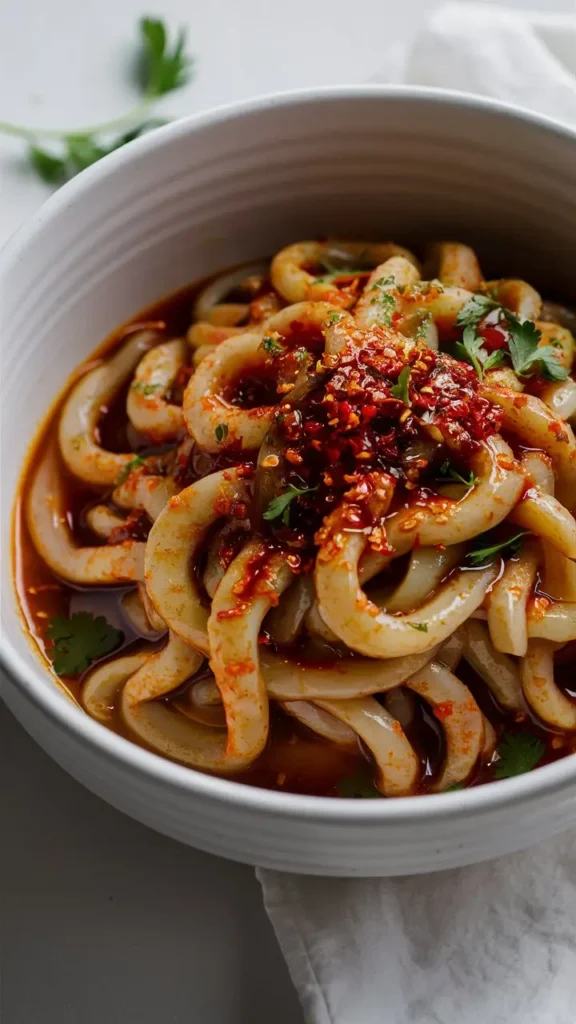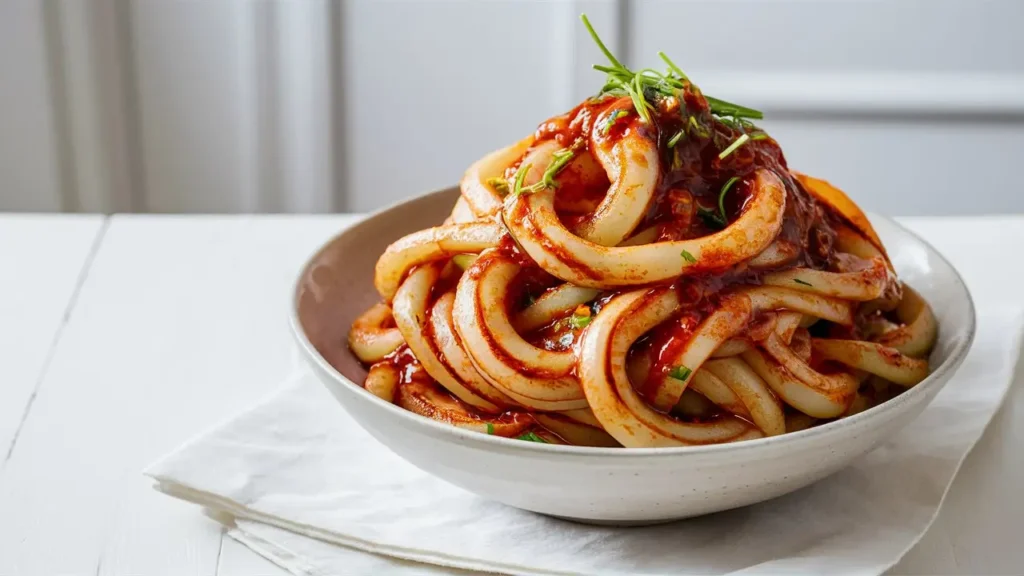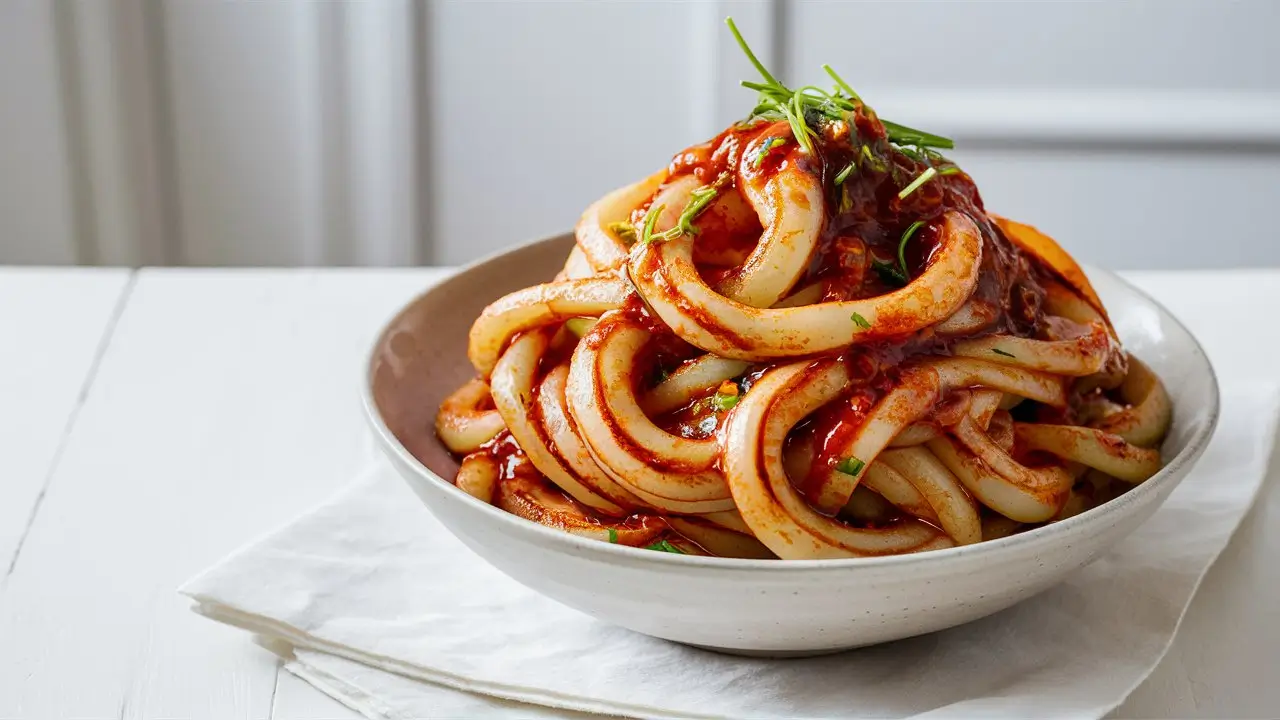Potato noodles are a soft, chewy, and satisfying type of noodle made using potato starch or mashed potatoes. Popular in various Asian cuisines—especially Korean and Chinese—these noodles are known for their unique texture and versatility. Whether stir-fried, tossed in sauce, or used in soups, potato noodles bring a delightful bite and comforting flavor to your bowl.
From Korean japchae to Chinese sweet potato starch noodles, or even homemade potato gnocchi-style noodles, there are many ways to enjoy this starchy favorite.

Why You Will Love This Recipe
-
Unique Texture: Chewy, slippery, and bouncy—different from traditional wheat noodles.
-
Naturally Gluten-Free: Perfect for gluten-free diets when made with potato starch.
-
Versatile: Works in stir-fries, soups, cold salads, and saucy dishes.
-
Easy to Customize: Pair with various proteins, vegetables, and sauces.
What Are Potato Noodles?
Potato noodles are made primarily from potato starch or mashed potatoes, sometimes combined with other starches or flour. These noodles are popular across different cuisines:
-
Korean sweet potato noodles (dangmyeon): Transparent, chewy noodles used in japchae.
-
Chinese hot pot noodles: Thicker, glassy noodles often used in broths.
-
Homemade potato noodles: Often made using mashed potatoes and flour, similar to gnocchi or spaetzle.
In all forms, these noodles are defined by their soft, elastic texture and ability to absorb flavor from sauces or broths.
Types of Potato Noodles
1. Korean Sweet Potato Noodles (Dangmyeon)
-
Made from sweet potato starch
-
Long, grayish when dry and glassy when cooked
-
Most famously used in Japchae
2. Chinese Potato Starch Noodles
-
Thick, wide, or long strands
-
Chewy and slippery
-
Used in stir-fries, soups, and hot pot
3. Homemade Mashed Potato Noodles
-
Made from mashed potatoes + flour or starch
-
Similar to gnocchi or hand-pulled dumplings
-
Pan-fried, boiled, or stir-fried
Basic Ingredients List
Here’s what you’ll need to make a simple version of homemade potato noodles from mashed potatoes.
For the Noodles:
-
2 cups mashed potatoes (cool and dry)
-
¾ to 1 cup all-purpose flour or potato starch
-
½ teaspoon salt
-
1 egg (optional, for extra binding)
Optional for Cooking:
-
Olive oil or butter (for frying)
-
Soy sauce or chili sauce (for seasoning)
-
Garlic, scallions, or sesame oil for garnish
Timing & Servings
-
Prep Time: 30 minutes
-
Cook Time: 15–20 minutes
-
Total Time: 45–50 minutes
-
Servings: 3 to 4
Step-by-Step Instructions (Homemade Version) for Potato Noodles
Step 1: Prepare the Mashed Potatoes
Boil peeled potatoes until fork-tender. Mash until smooth (no lumps). Let cool completely and dry slightly to avoid excess moisture.
Step 2: Make the Dough
In a bowl, combine mashed potatoes, flour/starch, salt, and egg (if using). Knead gently until a smooth, pliable dough forms. Add more flour if it’s too sticky.
Step 3: Shape the Noodles
Roll the dough into a long log. Slice into small portions and roll into ropes or press flat and cut into strips. You can also shape into gnocchi-like pieces by rolling over a fork.
Step 4: Boil the Noodles
Bring a pot of salted water to a boil. Drop in the noodles and cook for 3–4 minutes, or until they float. Remove with a slotted spoon and drain.
Step 5: Serve or Stir-Fry
You can serve the boiled noodles immediately with sauce or sauté them in a pan with oil, garlic, and seasonings for a stir-fried version.

Korean-Style Japchae with Potato Noodles
Ingredients:
-
7 oz Korean sweet potato noodles
-
1 carrot, julienned
-
½ onion, sliced
-
1 cup spinach or bok choy
-
4 oz beef or mushrooms
-
2 garlic cloves, minced
-
3 tablespoons soy sauce
-
1 tablespoon sesame oil
-
1 tablespoon sugar
-
1 teaspoon sesame seeds
Instructions:
-
Soak or boil the noodles until soft.
-
Stir-fry vegetables and meat.
-
Toss everything with soy sauce, sesame oil, sugar, and garlic.
-
Garnish with sesame seeds. Serve warm or at room temperature.
Potato Noodles vs. Regular Noodles
Feature Potato Noodles Wheat Noodles Main Ingredient Potato starch or mashed potatoes Wheat flour Texture Chewy, bouncy, slippery Firm or soft, depending on type Gluten-Free Yes (if made without flour) No Cooking Use Soups, stir-fries, hot pot Pasta, ramen, lo mein, etc.
Best Sauces for Potato Noodles
-
Soy Sauce & Garlic: Classic combo for stir-fry
-
Spicy Gochujang Sauce: For Korean flavors
-
Sesame & Scallion Dressing: Nutty and aromatic
-
Butter & Herbs: Simple, Western-style twist
-
Chili Oil: Great with Chinese-style wide potato noodles
These noodles absorb sauce well—just toss and coat thoroughly.
Tips for Perfect Potato Noodles
-
Avoid overworking the dough: It can become gummy.
-
Don’t skip drying mashed potatoes: Too much moisture leads to mushy noodles.
-
Cook in small batches: Prevents sticking and overcrowding.
-
Use cornstarch or oil to separate noodles after boiling if storing.
-
Pan-fry leftovers: They crisp up beautifully the next day.
How to Store and Reheat
Storing:
-
Let noodles cool completely. Store in an airtight container.
-
Keep in the refrigerator for up to 3 days.
Reheating:
-
Microwave: 1–2 minutes with a splash of water.
-
Skillet: Sauté with a bit of oil until warmed through.
-
Avoid freezing homemade mashed potato noodles—they can become mushy.
Nutritional Overview (Per Serving – Approximate)
-
Calories: 250–350
-
Carbohydrates: 45–50g
-
Protein: 4–6g
-
Fat: 4–8g (depending on additions)
-
Fiber: 2–3g
-
Gluten-Free: Yes, if made without wheat flour
These noodles are a good source of energy and potassium from potatoes.
Flavor Variations and Regional Twists
Korean Dangmyeon Variations:
-
Japchae (stir-fried with veggies and beef)
-
Hot Pot Noodles (served in boiling broths)
-
Spicy Cold Noodle Salad with sesame, cucumber, and gochugaru
Chinese Variants:
-
Wide potato starch noodles tossed in chili oil and garlic
-
Szechuan-style stir-fries with bold, spicy flavors
Western Style:
-
Serve with cream sauce, melted cheese, or even pesto for a fusion twist.
Make-Ahead Tips
-
You can prepare the dough and refrigerate it for up to 24 hours before shaping.
-
Pre-boiled noodles can be made a few hours in advance and tossed in oil to prevent sticking.
-
Cooked noodles reheat best in a skillet or lightly steamed.
FAQs
Can I use potato flour instead of starch?
Potato starch is ideal for chewy noodles. Potato flour may produce a denser texture and isn’t typically used in Asian-style noodles.
Are potato noodles gluten-free?
Yes—if made with 100% potato starch or mashed potatoes without added wheat flour.
Can I use instant mashed potatoes?
You can, but the texture may not be ideal. Fresh mashed potatoes give better elasticity.
Can I bake the noodles instead of boiling?
Boiling is essential for traditional texture. You can pan-fry or bake them after boiling for crispier textures.
Can I air-fry leftover potato noodles?
Yes! Toss with oil and air fry at 375°F (190°C) for 5–7 minutes for a crispy snack or side.
Conclusion
Potato noodles are a delightful way to switch up your regular noodle dishes. Whether you’re crafting chewy starch noodles for stir-fries or creating rustic mashed potato noodles from scratch, these versatile strands offer a uniquely satisfying texture and taste. They’re naturally gluten-free, endlessly adaptable, and always comforting.
